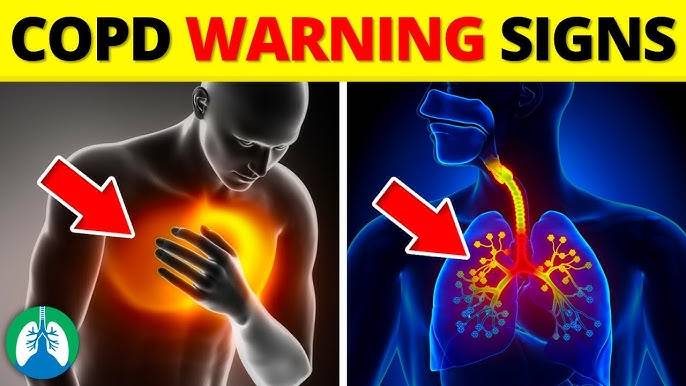5 Early Symptoms of COPD You Shouldn’t Ignore
Have you been brushing off a persistent cough or feeling winded while climbing the stairs? These could be early warning signs of Chronic Obstructive Pulmonary Disease (COPD), a long-term lung condition that affects millions worldwide. COPD progresses silently, often without noticeable symptoms until significant lung damage has occurred. Understanding these early symptoms is crucial to seeking timely medical attention, preventing complications, and improving quality of life.
Let’s explore the five early symptoms of COPD you shouldn’t ignore and why acting on them promptly can make all the difference.
What is COPD?
COPD, or Chronic Obstructive Pulmonary Disease, is a chronic lung condition characterized by persistent airflow obstruction, making breathing increasingly difficult. It includes conditions like chronic bronchitis and emphysema.
The primary cause of COPD is smoking, but long-term exposure to pollutants, dust, or genetic factors like alpha-1 antitrypsin deficiency can also play a role. While COPD cannot be cured, early detection allows for effective management and a slower progression of symptoms.
Why early detection matters:
Ignoring the early signs of COPD can lead to severe complications, including respiratory failure and a significant decline in the quality of life. Recognizing the symptoms early empowers individuals to take control of their health and seek medical help.
1. Persistent Cough
What to look for: A chronic cough that lingers for weeks or months, often worse in the morning or after exposure to irritants like smoke or pollutants.
Why it happens:
COPD inflames the airways, causing excess mucus production. The body tries to clear this buildup through coughing.
Why it’s important:
Many dismiss this as a “smoker’s cough†or seasonal cold, but a persistent cough is often the earliest sign of COPD. Left untreated, the underlying inflammation worsens, potentially leading to more severe symptoms.
What to do:
If you have a cough that doesn’t improve over time, see a doctor for a lung function test. Keeping a record of when the cough occurs and its severity can help during your consultation.
2. Shortness of Breath (Dyspnea)
What to look for: Difficulty catching your breath during activities that were once easy, such as walking, climbing stairs, or even mild exertion.
Why it happens:
In COPD, the airways narrow, and the lungs lose their elasticity. This makes it harder to exhale air, leaving less room for fresh oxygen.
Why it’s important:
Shortness of breath can significantly impact daily activities and reduce physical fitness over time. People often avoid exercise due to this symptom, leading to muscle deconditioning and worsening breathlessness.
What to do:
Don’t dismiss breathlessness as a sign of aging or being out of shape. Talk to your doctor about your symptoms and consider pulmonary rehabilitation programs that combine exercise and breathing techniques to improve lung function.
3. Wheezing
What to look for: A high-pitched whistling sound when you breathe, especially during exhalation.
Why it happens:
Wheezing occurs due to inflammation and narrowing of the airways, which obstruct airflow.
Why it’s important:
Wheezing isn’t just a sign of asthma; it can also indicate worsening COPD. Frequent wheezing episodes suggest the airways are significantly inflamed, requiring medical intervention.
What to do:
Track how often wheezing occurs and whether it worsens with physical activity or exposure to irritants like smoke or strong odors. A pulmonary function test can help determine the cause and severity.
4. Frequent Respiratory Infections
What to look for: Recurring colds, bronchitis, or pneumonia, often taking longer to recover from than usual.
Why it happens:
Damaged lungs are less effective at clearing out bacteria, viruses, and mucus. This makes individuals with COPD more susceptible to infections, which can further damage lung tissue.
Why it’s important:
Frequent infections not only worsen COPD symptoms but can also accelerate disease progression. Ignoring this sign increases the risk of hospitalization and long-term complications.
What to do:
Protect your lungs by getting vaccinated against the flu and pneumonia. Wash your hands regularly and avoid close contact with sick individuals. If you experience recurring infections, consult a doctor for preventive measures and potential antibiotic treatment.
5. Fatigue and Reduced Energy
What to look for: Feeling excessively tired or fatigued even after a full night’s rest. Everyday tasks like grocery shopping or household chores may feel exhausting.
Why it happens:
COPD reduces oxygen delivery to the muscles and organs, making your body work harder to perform simple activities. The extra energy expenditure can lead to constant tiredness.
Why it’s important:
Fatigue is often overlooked as a symptom of COPD but can drastically impact mental health and independence if left unaddressed.
What to do:
Prioritize activities, practice energy-conservation techniques, and maintain a balanced diet rich in iron and vitamins to boost energy. A doctor may recommend supplemental oxygen if fatigue is severe.
When to Seek Medical Attention
If you notice one or more of these symptoms, it’s time to consult a healthcare provider. Early diagnosis through tests like spirometry, chest X-rays, and blood tests can help determine if COPD or another condition is causing your symptoms.
Why it matters:
The earlier you seek help, the better your chances of slowing disease progression, improving lung function, and maintaining a high quality of life.
Tips for Managing COPD
Managing COPD is about adopting healthy habits and working closely with your healthcare provider. Here’s how to stay proactive:
1. Quit Smoking: The most critical step in preventing COPD progression is eliminating tobacco use. Seek support through counseling or cessation programs if needed.
2. Stay Active: Regular exercise strengthens respiratory muscles and improves endurance. Consult a pulmonary rehabilitation program for guidance.
3. Eat a Balanced Diet: Focus on nutrient-rich foods that support lung health, such as fresh fruits, vegetables, and lean proteins.
4. Avoid Triggers: Limit exposure to air pollution, secondhand smoke, and workplace irritants.
5. Use Medications as Prescribed: Inhalers and bronchodilators can ease breathing and reduce symptoms when used correctly.
COPD is a life-altering condition, but recognizing the warning signs early can make all the difference. Persistent coughing, breathlessness, wheezing, frequent infections, and fatigue are your body’s way of signaling that something isn’t right. Don’t ignore these symptoms—take action and consult a healthcare provider to safeguard your health.
By adopting a proactive approach and making lifestyle changes, you can effectively manage COPD and lead a fulfilling life. Remember, your health is in your hands, and taking the first step toward early detection can save you years of struggle. Take charge today!


